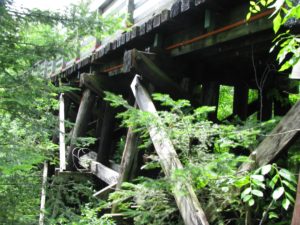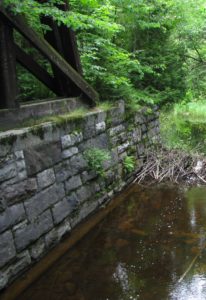Þórstína Þorleifsdóttir collected sources about Icelanders in N. Dakota in order to complete the work of her father, Þorleif Jóakimsson, to write a history of Icelanders in N. Dakota. He passed away on June 21, 1923, but Þórstína’s book, Saga Íslendinga i N. Dakota was published in 1926. She did a lot of work and searched for stories far and wide. Many settlers had disappeared, died or returned to Iceland. One settler was Þorsteinn (Thorsteinn) Jónsson whom she found in Englewood, a suburb of Los Angeles, California. He responded favorably to her request for information and sent her his story. She bases the story about Þorsteinn in her book somewhat on Þorsteinn’s story, let’s see what she wrote. (JÞ)

Railway bridge at Kinmount. Icelandic hands worked on it in the winter of 1874-1875. Photo by Jónas Þór
“Þorsteinn now lives in Englewood and has a nice home there. Because “Þorsteinn” sounds quite similar to “Foster” if not clearly pronounced, Þorsteinn allowed unenlightened natives of Canada to name him “Foster”. That name has been confirmed, and his signature is now: Foster Johnson, Box 126, R.F.D. No. 4, Englewood, Cal. Þorsteinn is undoubtedly a man of energy and hard work. He also does not lack initiative and sharp judgment when the going gets tough. His temperament is “practical”, his entire career bears witness to this. As a result, Þorsteinn’s talents are mainly manifested in the practical, that is to say in everyday work, but not in the spiritual and literary. For example, he writes: “From Quebec we travelled by rail to Toronto and stayed there two weeks. Then many people were moved north-west to Kinmount. It was the middle of October 1874. There were many people working on the railway that winter, and I was one of them. The following spring I moved with my wife to Millbrook, Ontario. We were there for two years, and we had both our children there. (Quite a few children died in the winter of 1874-1875 in Kinmount and Rósa, their two-year-old daughter, probably died there because he does not mention her in his story. Neither does Þórstína in her book; insert by Jónas Þór) I worked at a sawmill. In the summer of 1877 we moved to Winnipeg and stayed there that summer. In the fall I moved with my wife and two infants to New Iceland, took homestead rights to 160 acres of land and built on it a two-story house, 24×16, all of well-hewn “logs”, 5 inches thick, with a cellar underneath.” Þorsteinn remembers that he worked as a bricklayer in Winnipeg, and was paid $2 a day – a few improvements in a mason’s wages since that time – and Þorsteinn adds that his pay was 50c more than others got, but he was always ahead of others, so ”many gave up”. We named this our home, which was Steinkirkja. There I cleared two acres of forest. But we moved from there in June 1879, to Winnipeg”

Stacked stone wall under railway at Kinmount. Perhaps Þorsteinn had some part in making it. Photo by Jónas Þór
(Friðbjörg Guðlaugsdóttir, Þorsteinn’s wife, was from Steinkirkja in Fnjóskadal: insert by Jónas Þór) Þorsteinn did not stay long in Winnipeg. He writes: “In the fall of 1879 my wive and I moved to Pembina, N. D. and remained there until the spring; then I rented land. But in the fall we moved to homestead land on the so-called “Dakota Plains”. I set up a ”shanty”, 10×12, on my land. That fall, my mother came home from Iceland with her twelve-year-old granddaughter. There were six of us in this small house and we got along well. Great masses of snow this winter, and bad weather. I had to go 12 miles for firewood and often had a hard time getting home. (This winter is a memorable one for all the people there and is chronicled as a very harsh winter in the Northwestern states.) “It helped that I had a good horse-”team”, which navigated well.”
From there, Þorsteinn’s life became easier. His estate was constantly flourishing and blessed; he added 320 acres of land, which cost him $3000, and bought a threshing machine for $3500, which he used for threshing in the community. In 1903 he sold his farm and moved to the village of Cavalier, N. D., but did not stay there long, because rheumatism afflicted him, and so he went to Colorado, and settled there for about three years. He was successful, both financially and in health. He concludes: “In the spring of 1917 I sold out in Colorado and moved to Los Angeles, Cal., because my daughter and her husband had been there before, and liked it so much that they encouraged us to come there to them, and we did. In January 1918, I bought a building with two elevators, and bought goods to start a grocery business, although it did not appeal to me, as I knew nothing about that business. My wife and I worked at it for two years, and it went amazingly well, until in June, 1920, she was taken ill and it led to her death. – I have now stopped working and just take care of myself; 76 years old, healthy and fit and very satisfied.”
